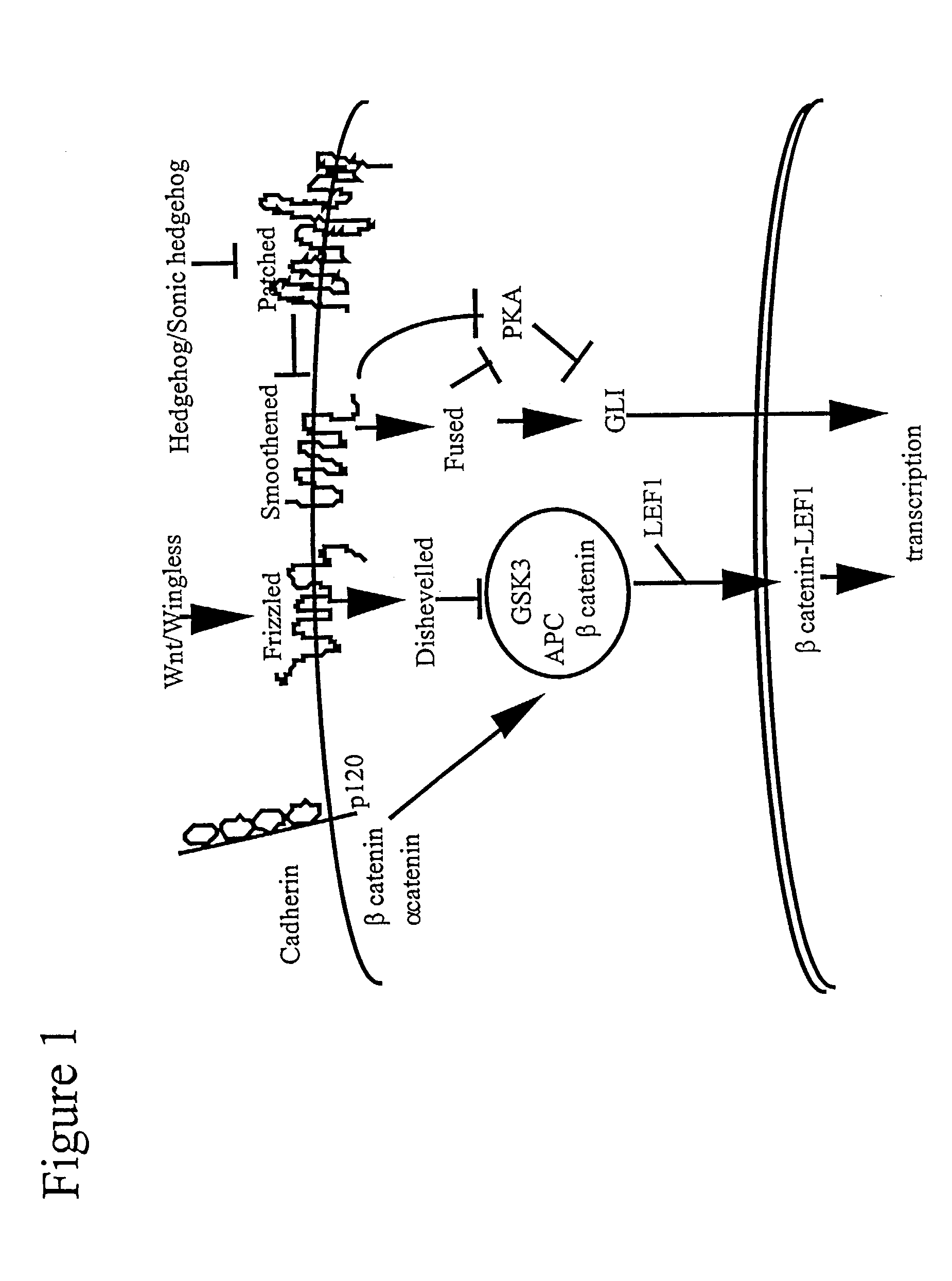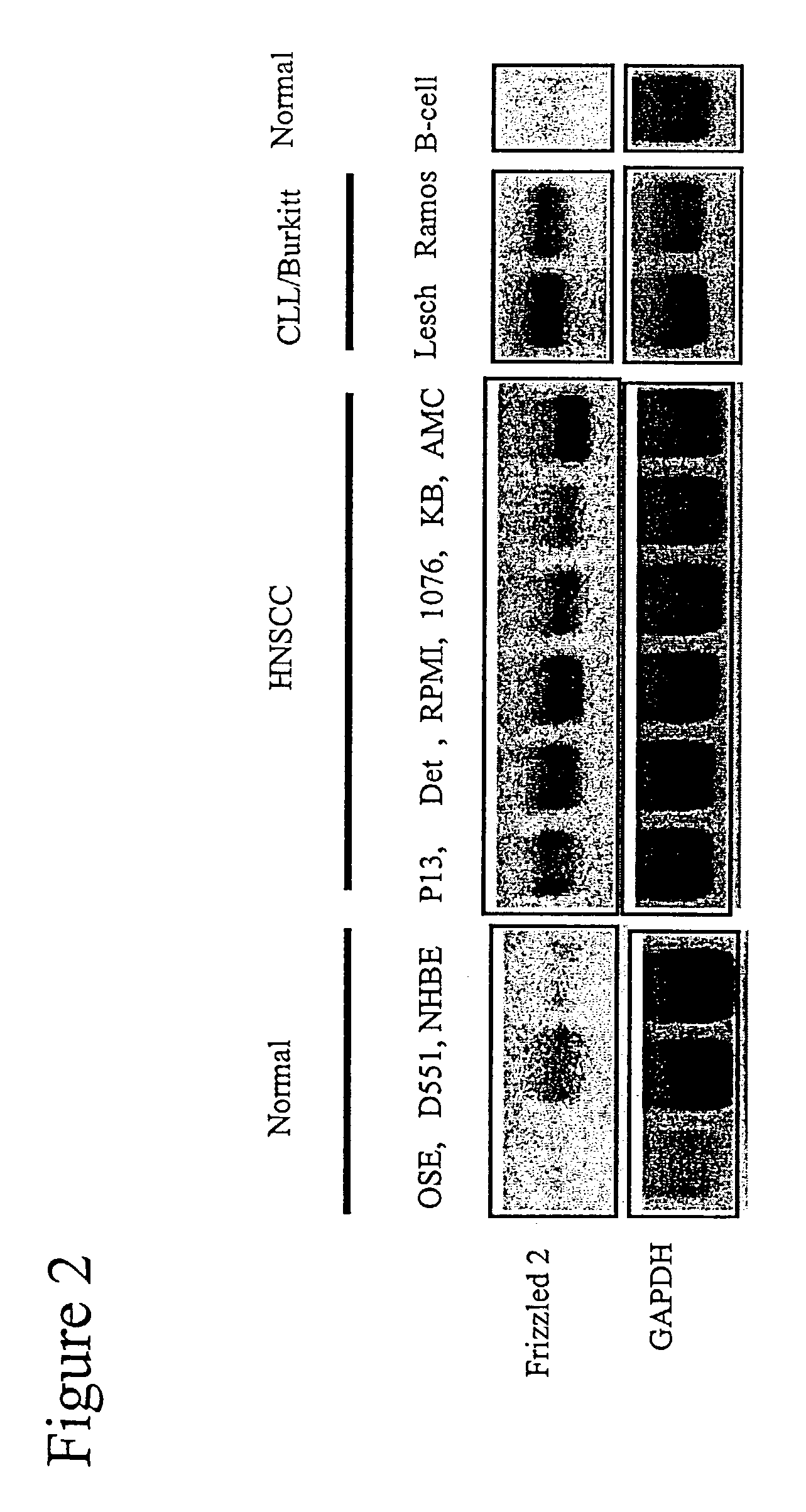Wnt and frizzled receptors as targets for immunotherapy in head and neck squamous cell carcinomas
a squamous cell carcinoma and immunotherapy technology, applied in the direction of antibody medical ingredients, drug compositions, peptides, etc., can solve the problems of insufficient control of selvage in microarrays, and the inability of hybridization in microarrays to distinguish closely related templates, so as to inhibit proliferation or survival, and facilitate cellular toxicity or killing
- Summary
- Abstract
- Description
- Claims
- Application Information
AI Technical Summary
Benefits of technology
Problems solved by technology
Method used
Image
Examples
example 1
Immunogenicity of Isolated Non-Homologous Regions of Frizzled 2
[0228]The first extracellular domain of frizzled 2 contains a region which based on protein structure is least homologous to the other frizzled protein family members (FIG. 6) (Sagara, N. et al. “Molecular cloning, differential expression, and chromosomal localization of human frizzled-1, frizzled-2, and frizzled-7,” Biochem Biophys Res Commun 252:117-122 (1998)). This polypeptide sequence may have sufficient ternary structure to generate an antibody response to the native protein. In order to enhance B cell stimulation this epitope will be coupled to T cell epitopes that have been described to generate T cell help.
[0229]The overall strategy will be to use the least conserved region of the frizzled protein, attempting to preserve the most native structure possible and to generate the most potent immune response. The most versatile method for designing vaccines of defined regions is naked plasmid DNA. The advantages are t...
example 2
Expression of Wnt and Fzd mRNAs in HNSCC
[0241]Ten different HNSCC cell lines, two normal human broncho-epithelial (NHBE) cell lines, and normal oral squamous epithelial cells were tested by RT-PCR for the expression of five Wnts (Wnt-1, Wnt-5a, Wnt-7a, Wnt-10b, Wnt-13), and two Fzds (Fzd-2 and 5). Representative results are illustrated in FIG. 8 and are summarized in Table 1. When compared to the housekeeping gene G3PDH, all the Wnts, as well as Fzd-2, were expressed more frequently in HNSCC than in normal cells, while there was no difference in Fzd-5 gene expression. Of the Wnt genes, Wnt-1, 5a, and 10b were most strongly expressed by the malignant cells, but were barely detectable in the normal tissues tested. We then investigated further Wnt-1 and Wnt-10b, since these Wnts signal through the canonical β-catenin and LEF / TCF, and because antibodies to the extracellular domains were available.
example 3
Expression of Wnt / Fzd Proteins in HNSCC
[0242]Cell lines were lysed and analyzed for Wnt-1, Wnt-10b, Fzd-2, and β-catenin protein expression by immunoblotting (FIG. 9). The normal cells expressed much less of these Wnt or Fzd proteins, when compared to the tested HNSCC, with the exception of RPMI 2650. Of note is the lack of detectable Fzd protein in the lysate of the NHBE cell line that had a weakly detectable product by RT-PCR. Beta-catenin was detected in all the samples, including both HNSCC and NHBE lines.
PUM
| Property | Measurement | Unit |
|---|---|---|
| Tm | aaaaa | aaaaa |
| concentrations | aaaaa | aaaaa |
| concentrations | aaaaa | aaaaa |
Abstract
Description
Claims
Application Information
 Login to View More
Login to View More - R&D
- Intellectual Property
- Life Sciences
- Materials
- Tech Scout
- Unparalleled Data Quality
- Higher Quality Content
- 60% Fewer Hallucinations
Browse by: Latest US Patents, China's latest patents, Technical Efficacy Thesaurus, Application Domain, Technology Topic, Popular Technical Reports.
© 2025 PatSnap. All rights reserved.Legal|Privacy policy|Modern Slavery Act Transparency Statement|Sitemap|About US| Contact US: help@patsnap.com



